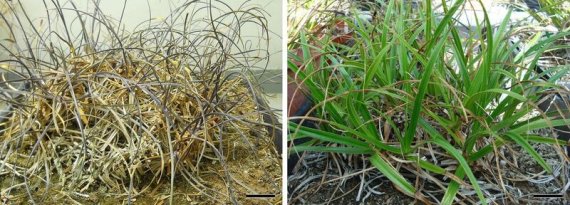The plant that goes by the name Xerophyta viscosa is two-faced. During droughts, it is merely a collection of dry leaves. When it rains, however, it becomes an exuberantly blooming green plant with tiny lilac flowers. This property is very interesting for food crops, which is why a team of researchers from South Africa, the USA, Australia and the Netherlands mapped the DNA of this ‘resurrection plant’.
Desiccation
Wageningen plant physiologists Maria-Cecília Costa and Mariana Artur studied the expression patterns of the genes to determine which genes are turned on and off by the plant during desiccation. To their surprise, they found no additional activity among the genes involved in the withering and aging of the plant. What they did find, however, was additional activity of the genes involved in the maturation of the seeds: a process in which the seeds are prepared to survive decades of drought. The research was published yesterday in Nature Plants.
Mechanism
‘This process of full desiccation is not the same as desiccation tolerance’, explains research supervisor Henk Hilhorst. ‘With desiccation tolerance, the plant can limit water loss by closing its stomata, for example. But after some time without water, such a desiccation tolerant plant will still perish. The Xerophyta viscosa is able to fully desiccate without perishing. It has a mechanism that prevents damage from occurring during drought. That is the mechanism we are looking for.’
What is peculiar about this mechanism is that is protects the seeds of most plants during extreme droughts, but not their green parts. If Hilhorst’s group discovers the genes, they might be able to activate the genes in such a way that they would also protect the leaves of the plants. Eventually, they hope to activate this property in food crops.
Teff
Hilhorst now knows in what direction he should search, but he does not yet dispose of the gene package that is responsible for the resurrection. Further research into a different crop should help him advance. His group is currently also analysing the genes of teff (Eragrostis tef), a food crop native to Ethiopia, and of a close relative of teff that is desiccation tolerant. By comparing the genes of these two species, they hope to find the mechanism they are searching for.
Hilhorst says that the rain-dependant African agriculture would benefit most from food crops that could withstand bone-dry circumstances, referring to countries plagued by drought and hunger, such as Ethiopia, South Sudan and Northern Nigeria.

